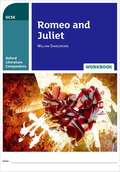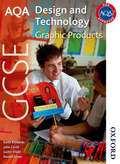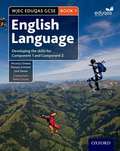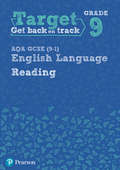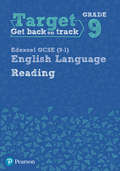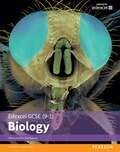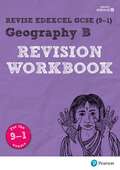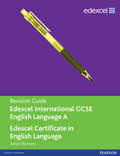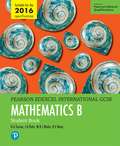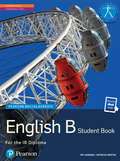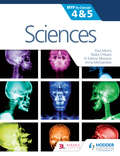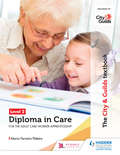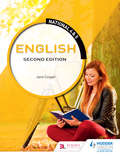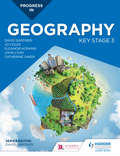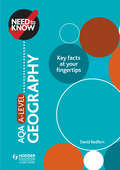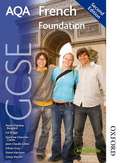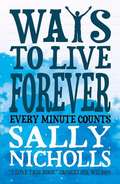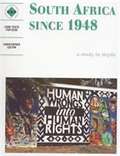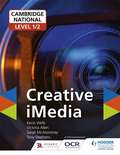- Table View
- List View
Oxford Literature Companions: Romeo and Juliet, GCSE Workbook (PDF)
by Adrian Cropper Peter BuckroydEasy to use in the classroom or as a tool for revision, Oxford Literature Companion Workbooks provide student-friendly support for a range of popular GCSE set texts. Each write-in workbook offers a range of varied and in-depth activities to deepen understanding and encourage close work with the text, covering characters, themes, performance, language and contexts. Each workbook also includes a comprehensive Skills and Practice section, which provides advice onassessment and sample student exam answers. This workbook covers Romeo and Juliet by William Shakespeare.
AQA Design and Technology GCSE: Graphic Products (PDF)
by John Bed Ma Ed Mgt Npqh Cavill Justin Dodd Keith Richards Russel JonesEnsure stress-free success in Controlled Assessment AQA GCSE Damp;T Graphic Products provides a unique blend of AQA approved print and online resources for the new 2009 specifications. Includes a student's book and online assessment materials delivered via kerboodle!
AQA GCSE French Higher: student book
by Ginny March Jean-Claude Gilles Marie-Thérèse Bougard Oliver Gray Steve HarrisonWritten for the AQA GCSE French specification, this higher tier student book provides comprehensive coverage of the contexts and topics. The higher tier book reinforces the basics and offers extra challenges for students who are aiming as high as A/A*.
WJEC Eduqas GCSE English Language: Book 1 (PDF)
by Michelle DoranStudent Book 1 develops the key reading and writing skills that students will be assessed on in Component 1 and Component 2 of the WJEC GCSE English Language qualification. Structured around the Assessment Objectives, the book engages students through a thematic approach with inspiring texts that helps prepare students for the thematic connections they will face in the examinations. Through a range of texts, activities, stretch and support features as well as tipsand key terms, this book helps students of all abilities develop their reading and writing skills. Spelling, punctuation and grammar activities and guidance are provided in context to help improve students' technical accuracy. In addition to the regular peer and self-assessment activities, teachers canmonitor progress through the substantive end-of-chapter assessments and the sample exam papers.
Target Grade 9 Reading AQA GCSE (Intervention English)
by PearsonThese books are for the latest AQA GCSE English (9-1) This workbook: targets key misconceptions and barriers to help your students get back on track addresses areas of underperformance in a systematic way, with a unique approach that builds, develops and extends students' skills gets students ready for the new GCSE English (9-1) assessments with exercises focused around exam-style questions provides ready-to-use examples and activities freeing up your time to focus on working directly with students fits around your needs, being flexible as part of an intervention strategy or for independent student work. Each unit addresses an area of difficulty with a unique approach, to develop and extend students' skills.
Target Grade 9 Edexcel GCSE: Target Grade 9 Reading Edexcel GCSE (9-1) English Language Workbook (Intervention English)
by PearsonThis workbook: targets key misconceptions and barriers to help your students get back on track addresses areas of underperformance in a systematic way, with a unique approach that builds, develops and extends students' skills gets students ready for the new GCSE English (9-1) assessments with exercises focused around exam-style questions provides ready-to-use examples and activities, aligned to the Pearson Progression Map, freeing up your time to focus on working directly with students fits around your needs, being flexible as part of an intervention strategy or for independent student work. Each unit addresses an area of difficulty with a unique approach, to develop and extend students' skills.
Edexcel GCSE (Edexcel (9-1) GCSE Science 2016)
by Mark Levesley Susan KearseyThis Student Book uses the Pearson Checkpoint learning approach, which has been designed to help students to develop the skills required for the exams. The Checkpoint Teaching and Learning approach will help students to remember the key learning points from each topic, and to use their learning to apply, analyse and evaluate in new contexts. This support will help to develop the full range of skills that will be assessed in the exam. Other key features of the Student Book include: a Preparing for the Exam section at the end of every Topic, to help students understand how six mark questions will be assessed Core Practical pages that give students the opportunity to practice answering practical-based exam questions Questions that are all rated on a scale of 1 to 12 using the Pearson Steps system, encouraging students to answer increasingly difficult questions as they progress through the course.
Miscellaneous Laboratory Equipment 1 (UEB Contracted)
by RnibThis page shows eight items of laboratory equipment. All are seen from the side in cross section, except the micro-chambered test slide in the top left corner of the page, which is viewed from the top. There is a locator dot and title shown, which will be at the top left of the page when it is the correct way up. The items are arranged in three columns with each item labelled down the page.
Meiosis Phase One (UEB Uncontracted)
by RnibThese pages show late interphase before meiosis, and five stages of meiosis phase one. There is a locator dot shown on each page, which will be at the top left of the page when the image is the correct way up. Meiosis is cell replication where a cell divides to produce four non-identical gametes, each with only one set of chromosomes instead of the usual two sets found in all other cells.Late interphase before meiosis. This page shows a cell immediately before meiosis starts. The cell is a large rounded shape in the centre of the page. Its nucleus fills the bottom of the cell and two centrioles are in the top of the cell. The twenty three pairs of chromosomes in the nucleus have replicated to form a mass of chromatids (double chromosomes) which are tightly coiled. Note the size of the nucleus and the centrioles in relation to the overall size of the cell are greatly enlarged for clarity. Only some of the chromatin is shown, also for clarity. Meiosis - stage one, early prophase I. This page shows the start of meiosis. The cell is in the centre of the page. In the top of the cell the centrioles to the left and right have the mitotic spindle growing between them. The nucleus shows two chromatids - the double chromosomes. The ends of the chromosomes of the chromatids are crossed in two places, to the top and bottom of the pair. In reality in humans there would be twenty three pairs of chromatids.Meiosis - stage one, late prophase I. This page shows chromatids after crossover. The cell is in the centre of the page. In the top of the cell the centrioles to the left and right have the mitotic spindle growing between them. The nucleus shows two chromatids - the double chromosomes. The ends of the chromosomes of the chromatids have swapped DNA coding where they were crossed. The ends to the top centre of the chromatids have swapped and the ends of the other pair of chromosomes to the bottom centre have also swapped.Meiosis - stage two, metaphase I. This page shows the completed mitotic spindle with a centriole to the left and right. The nuclear envelope has disappeared. The chromatids have attached themselves side by side to the centre of the spindle on the central microtubule by their centromeres in the centre of the image. For clarity other chromatids are not shown so the microtubule to the top and bottom of the image appears empty. In reality there would be many more pairs of chromatids and microtubules.Meiosis - stage three, anaphase I. This page shows the centromeres have separated. The microtubules of the spindle are retracting to the left and right. Each chromatid of the pair of chromosomes are migrating to opposite ends of the spindle to the left and right.Meiosis - stage four, telophase I. This page shows centrioles to the left and to the right. One chromatid is in the left and one chromatid is in the right of the cell. To the top and bottom centre of the cell the plasma membrane is pinching in and starting to divide the cytoplasm.
The Crucible: A Play In Four Acts (Modern Classics Ser.)
by Arthur MillerArthur Miller's classic parable of mass hysteria draws a chilling parallel between the Salem witch-hunt of 1692 - 'one of the strangest and most awful chapters in human history' - and the McCarthyism which gripped America in the 1950s. The story of how the small community of Salem is stirred into madness by superstition, paranoia and malice, culminating in a violent climax, is a savage attack on the evils of mindless persecution and the terrifying power of false accusations.
Revise Edexcel GCSE: for home learning, 2022 and 2023 assessments and exams (Revise Edexcel GCSE Geography 16)
by Andrea WoodOur revision resources a re the sma rt choice for those revising for Edexcel GCSE (9–1) Geogra phy B. This book will help you to: • Organise your revision with the one-topic-per-pa ge forma t • Prepare for your GCSE ex am with book full of exa m-style pr actice questions • Simplify your revision by writing stra ight into the book just as you would in a n ex am • Track your progress with a t- -gla nce check boxes • Improve your underst anding, and exa m technique, with guided questions to build confidence, and hints to support key revision points.
Edexcel International GCSE/certificate English A Revision Guide (Edexcel International GCSE)
by Anna O'KennedyThis revision guide provides preparation for the Edexcel International GCSE English A/Edexcel Certificate in English Language examination.
Edexcel International GCSE Mathematics B Student Book (Edexcel International GCSE)
by I A Potts D. A TurnerEdexcel's own Student Book for the new 2009 Edexcel International GCSE Mathematics specification. Provides complete coverage of the 2009 Edexcel International GCSE Mathematics specification. Attractive, full-colour design and engaging features makes the title accessible for every student. Contains exam practice throughout, with revision questions and practice exam questions. Linked to additional online material for students and teachers, provided by Edexcel, ensuring that you have as much support as possible. Full answers to the Student Book questions are available to teachers and parents by emailing customersolutions@pearson.com (for UK teachers and parents) or icsorders@pearson.com (for all other teachers and parents).
Pearson Education Baccalaureate English B print and ebook bundle for the IB Diploma: Industrial Ecology (Pearson International Baccalaureate Diploma: International Editions)
by Patricia MertinA comprehensive textbook with interactive eText written by expert practising IB teachers. Suitable for both Standard and Higher Levels, it provides targeted support to help learners achieve their potential: Comprehensive coverage of the latest curriculum A wealth of topical authentic texts and visual stimuli, accompanied by a broad range of questions and exercises. Teaches and practises the key skills required for the oral and written assessments, including the latest changes to the written assignment. Links to intercultural themes and Theory of Knowledge throughout. An interactive eText with supportive functionality such as searching, bookmarking, note-taking and highlighting.
Sciences for the IB MYP 4&5 By Concept (PDF)
by Paul MorrisDevelop your skills to become an inquiring learner; ensure you navigate the MYP framework with confidence using a concept-driven and assessment-focused approach to Sciences presented in global contexts.A* Develop conceptual understanding with key MYP concepts and related concepts at the heart of each chapter. A* Learn by asking questions for a statement of inquiry in each chapter. A* Prepare for every aspect of assessment using support and tasks designed by experienced educators.A* Understand how to extend your learning through research projects and interdisciplinary opportunities.A* Think internationally with chapters and concepts set in global contexts.
City & Guilds Textbook Level 2 Diploma in Care for the Adult Care Worker Apprenticeship (PDF)
by Peteiro Maria FerreiroExcel in Adult Care with the ideal companion for the Level 2 Diploma, published in association with City & Guilds and written by expert author, Maria Enhance your portfolio with key advice and activities linked to assessment criteria, making it easier to demonstrate your knowledge and skills. -Manage the demands of your course with assessment criteria translated into simple, everyday language and practical guidance.-Understand what it means to reflect on practice with 'Reflect on it' activities, and guidance on how to write your own reflective accounts.-Learn the core values of care, compassion, competence, communication, courage and commitment required as an Adult Care worker.-Summarise and check your understanding with 'Knowledge, Skills, Behaviours' tables at the end of each learning outcome.-Successfully apply Adult Care theory in the workplace, using real-world case studies to guide you.-Expand your learning with access to popular optional units available online.
National 4 & 5 English Second Edition (PDF)
by Jane CooperThis new edition of the National 4 & 5 English textbook is fully up to date for National 4 and 5 courses, including the latest updates to National 5. It recognises the removal of Purpose and Audience from both courses, and includes new material for Reading for Understanding, Analysis, and Evaluation at National 5, and for the National 5 Spoken Language Assessment.Throughout the book, the necessary skills or areas of knowledge are introduced gradually, tested with brief activities, demonstrated again, and then reinforced with end-of-chapter activities and questions that mirror SQA examination papers.Ensure your students are prepared for every aspect of their assessment with fully comprehensive coverage of the new syllabus requirements:- updated to support the new course specification and address all skills covered in the SQA examinations- reflects changes in the set text list- provides thorough exam preparation, with Practice Exercises, and associated answers and mark schemes- includes a new focused revision tips section- written by a highly experienced and respected author- provides an engaging and practical pathway through the syllabus- organised to make it easy to plan, manage and monitor student progress.
Progress in Geography Key Stage 3 (PDF)
by David GardnerMotivate pupils to develop their geographical skills, knowledge and understanding as they become engaged and accomplished geographers, ready for the demands of GCSE.Specifically designed to provide a solid foundation for the 2016 GCSE specifications, this Student Book takes an enquiry-based approach to learning within each unit and lesson.- Easily and cost-effectively implement a new KS3 scheme of work: this coherent single-book course covers the latest National Curriculum content, providing 150 ready-made lessons that can be used flexibly for a two or three-year KS3- Build and improve the geographical knowledge and skills that pupils need: every double-page spread represents a lesson, with rich geographical data and place contexts for pupils to interpret, analyse andevaluate- Lay firm foundations for GCSE: key vocabulary, command words and concepts are introduced gradually, preparing pupils for the content and question types they will encounter at GCSE, with a particular focus on analysis and evaluation questions- Effectively assess, measure and demonstrate progress: formative assessments throughout each lesson and summative end-of-unit reviews include questions that show whether pupils are 'working towards', 'meeting' or 'exceeding' expectations- Encourage pupils to check and drive their own progress: learning objectives and end-of-unit learning outcomes help pupils reflect on their learning and make connections between key concepts and skills throughout the course
Need to Know AQA A-level Geography (PDF)
by David RedfernThis new edition of the National 4 & 5 English textbook is fully up to date for National 4 and 5 courses, including the latest updates to National 5. It recognises the removal of Purpose and Audience from both courses, and includes new material for Reading for Understanding, Analysis, and Evaluation at National 5, and for the National 5 Spoken Language Assessment.Throughout the book, the necessary skills or areas of knowledge are introduced gradually, tested with brief activities, demonstrated again, and then reinforced with end-of-chapter activities and questions that mirror SQA examination papers.Ensure your students are prepared for every aspect of their assessment with fully comprehensive coverage of the new syllabus requirements:- updated to support the new course specification and address all skills covered in the SQA examinations- reflects changes in the set text list- provides thorough exam preparation, with Practice Exercises, and associated answers and mark schemes- includes a new focused revision tips section- written by a highly experienced and respected author- provides an engaging and practical pathway through the syllabus- organised to make it easy to plan, manage and monitor student progress.
AQA GCSE French Foundation: Student Book
by Ginny March Jean-Claude Gilles Lol Briggs Marie-Therese Bougard Oliver Gray Severine Chevrier-Clarke Steve HarrisonThe 2nd edition of the best-selling AQA GCSE French course, closely reflecting the structure of the AQA specification and provides students with excellent preparation for exam success.
Miscellaneous laboratory equipment 1 (UEB Uncontracted)
by Rnib BookshareThis page shows eight items of laboratory equipment. All are seen from the side in cross section, except the micro-chambered test slide in the top left corner of the page, which is viewed from the top. There is a locator dot and title shown, which will be at the top left of the page when it is the correct way up. The items are arranged in three columns with each item labelled down the page.
Meiosis phase two (Large Print)
by Rnib BookshareThese pages show the four stages of the second phase of meiosis and non-identical gametes as a product of meiosis. There is a locator dot shown on each page, which will be at the top left of the page when the image is the correct way up. Meiosis is cell replication where a cell divides to produce four non-identical gametes, each with only one set of chromosomes instead of the usual two sets found in all other cells.Meiosis - stage five, prophase II. This page shows the start of the second phase of meiosis. The original cell has divided into two non-identical cells. There is a cell to the left and right of the page. The cell to the left has a pair of centrioles in the bottom and a single chromatid in the top of the cell. The cell to the right has a pair of centrioles in the top and a single chromatid in the bottom of the cell. In reality in humans there would be twenty three chromatids in each cell.Meiosis - stage six, metaphase II. This page shows a cell to the left and right. Each has a completed mitotic spindle with a centriole to the top and bottom. The chromatids have attached themselves to the centre of each spindle on the central microtubule by their centromeres in the centre of each cell. For clarity other chromatids are not shown so the microtubule to the left and right of each cell appears empty. In reality there would be many more chromatids and microtubules.Meiosis - stage seven, anaphase II. This page shows the centromeres have separated in each cell to the left and right of the page. The microtubules of the spindle are retracting to the top and bottom. The chromatids have split, and each chromosome of each chromatid are migrating to opposite ends of the spindle to the top and bottom in each cell.Meiosis - stage eight, telophase II. This page shows two cells with centrioles to the top and bottom. There is a single chromosome to the top and bottom centre of each cell. The plasma membrane is pinching in from the left and right and starting to divide the cytoplasm in each cell. Four non-identical gametes produced The cells have divided to form four genetically non-identical cells. Each has only one of the original pair of chromosomes. In reality each gamete would have one set of twenty three chromosomes, only one is shown for clarity.
Ways To Live Forever
by Sally NichollsMy name is Sam. I am eleven years old. I collect stories and fantastic facts. By the time you read this, I will probably be dead. Sam loves facts. He wants to know about UFOs and horror movies and airships and ghosts and scientists, and how it feels to kiss a girl. And because he has leukaemia he wants to know the facts about dying. Sam needs answers to the questions nobody will answer. WAYS TO LIVE FOREVER is the first novel from an extraordinarily talented young writer. Funny and honest, it is one of the most powerful and uplifting books you will ever read.
South Africa Since 1948: A Study In Depth (PDF)
by Christopher CulpinStretch and challenge your students with SHP's longest-lived and best-selling series for GCSE History. This is an SHP Official Text which means it has been created by the Schools History Project for use with the GCSE specifications. This is part of SHP's comprehensive and authoritative range of books for the GCSE History. Click here to find out more about the Schools History Project and their award winning publications. South Africa 1948-1995 This title is a comprehensive and authoritative depth study for use with all GCSE level specifications. It thoroughly covers the content requirements of the OCR, Edexcel, AQA and CIE specifications using an enquiry-based approach. It is also a popular international text being widely used in Australia. It is written by experts who understand both how to design good teaching material but also understand the exact assessment requirements of each specification.
Cambridge National Level 1/2 Creative iMedia (PDF)
by Kevin Wells Victoria Allen Sarah McAtominey Tony StephensStrengthen learners' grasp of the most challenging units and develop the skills required for success with this essential student book mapped to the Cambridge National Level 1 / 2 in Creative iMedia. Covering the mandatory and optional units, this textbook will help to build knowledge, reinforce classroom learning and test the students' understanding. · Builds students' knowledge with clearly-focused content to aid progression and activities to assess understanding. · Prepares your students for both internal and external assessment with opportunities to test and consolidate understanding. · Support your students' progress through the course with the only textbook published for the Cambridge National Level 1 /2 in Creative iMedia.
